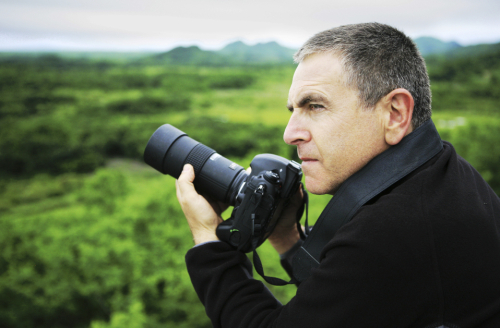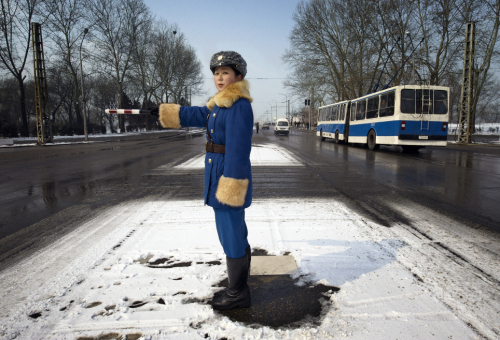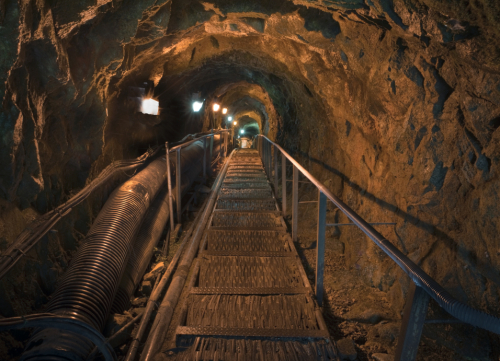A photographer’s day trip to grounds of Korean War
By Park Min-youngPublished : July 1, 2011 - 21:29
Mark Edward Harris takes on Iron Triangle, once the most ferocious battlefield along the DMZ, in time for 61st anniversary of the Korean War
CHEORWON, Gangwon Province ― Rain was drizzling down as photographer Mark Edward Harris headed for Cheorwon, Gangwon Province on June 24. He had just arrived at Incheon International Airport a few hours earlier.
“They’ll be just more moody,” Harris told The Korea Herald when asked if the rain would be an obstacle to taking photos.
“It is very good weather to do portraits because there are no shadows.”
Though he stored most of his luggage in the car trunk, he took his Tamrac trolley securing his two cameras ― Nikon D3 and D3X ― with him in the back seat for the three-hour ride from Seoul to Cheorwon, just in case he needed to shoot something right away.
It was his 10th trip to the Korean Peninsula, including four to the North. Harris, who is considered one of the best U.S. travel photographers of today, said the unique situation of the two Koreas greatly interested him.
“It is so unusual in the fact that it is unresolved ― that’s also the issue in the Middle East. People tend to be so shortsighted, but they have to look at history to understand the present. I am not a super expert on Korean history but I have a sense of how one event led to another,” he said.
CHEORWON, Gangwon Province ― Rain was drizzling down as photographer Mark Edward Harris headed for Cheorwon, Gangwon Province on June 24. He had just arrived at Incheon International Airport a few hours earlier.
“They’ll be just more moody,” Harris told The Korea Herald when asked if the rain would be an obstacle to taking photos.
“It is very good weather to do portraits because there are no shadows.”
Though he stored most of his luggage in the car trunk, he took his Tamrac trolley securing his two cameras ― Nikon D3 and D3X ― with him in the back seat for the three-hour ride from Seoul to Cheorwon, just in case he needed to shoot something right away.
It was his 10th trip to the Korean Peninsula, including four to the North. Harris, who is considered one of the best U.S. travel photographers of today, said the unique situation of the two Koreas greatly interested him.
“It is so unusual in the fact that it is unresolved ― that’s also the issue in the Middle East. People tend to be so shortsighted, but they have to look at history to understand the present. I am not a super expert on Korean history but I have a sense of how one event led to another,” he said.

Harris started his career as a professional photographer after graduating from California State University, Los Angeles, with a M.A. in pictorial/documentary history. He has traveled to 83 countries so far and published several books, including the award-winning “Inside North Korea” which features photos he took during his trips to the peninsula up until 2006.
The day’s visit to Cheorwon was focused at getting a better view of the Iron Triangle, the region situated between Cheorwon, Gimhwa and Pyeonggang where the most ferocious battles took place during the Korean War. Harris had visited the area before in January 2003.

He was back to recapture the scenes in color, having taken his shots in black and white at the time. But aside from looking for the photo spots he had been to before, he said he would be going there as “an empty cup,” ready to take whatever he came across.
The 49-year-old photographer could not hide his excitement as the car pulled into the military grounds.
“This is it. It is so amazing and bizarre that the place is still a no-man’s land 60 years after the war,” he said, trying to get a glimpse of the Demilitarized Zone as the car moved close to the border.
As if by some magic, the sky cleared up as soon as Harris started to shoot photos. And, as if by yet more magic, a blue-striped bus suddenly pulled up in front of the Exhibition Pavilion of the Iron Triangle and unloaded a military band dressed in red and white. The band lined up in front of the bus and Harris got right in front of them, faced the leader, and took some shots.
“You’d think what are the odds ... it happens sometimes. It might actually be the establishing photo I took today, right here in the parking lot,” said Harris.
A mother and daughter started to step back when Harris pointed his camera at them. But surprisingly, they shyly returned to pose when he gestured them to stay, giving them a soft smile. It was an almost unbelievable sight ― Koreans responding positively to a total stranger trying to take their photo. Harris admitted that part of the reason was that he is a foreigner.
“But you should also try to become a part of whatever it is that you are trying to shoot,” he said, telling how he got naked and hopped into hot tubs with his subjects in Japan to shoot photos in his book “The Way of the Japanese Bath.”
After grabbing a cup of ramen at a convenience store nearby ― which Harris enjoyed by adding a whole mini bag of kimchi ― PR officials from the Ministry of National Defense led us into the restricted area. We were able to visit several more spots than tourists normally get to see.
It took about a 15-minute ride in the restricted area ― which looked just like any peaceful span of rice fields except for the little red “mines” signs ― to reach the 2nd Underground Tunnel. The North Koreans had dug up to 1.1 kilometers south from the military demarcation line until it was discovered in 1976. At least 15,000 soldiers could have invaded the South through it within an hour, explained the guide. Harris was only allowed to take photos at the entrance.

If the 2nd tunnel showed the wonders of human power, the DMZ viewed from the Peace Observatory presented the wonders of nature. It was a rare sight ― nature that has been untouched for more than 60 years ― blessed with beautiful weather. The morning rain had removed the usual fog and it was possible to see all the way to Haeri hill which Harris had so anticipated. A major battle between U.N. allied forces and the North Korean soldiers took place there for nine days at the tail end of the Korean War.
“It’s a boring picture of a ridge but if you know what happened, it’s something. You’d wish mountains could talk, right?” said Harris, showing the photo he just took.
But the photographer had to give up what could have been the best photo of the day: a group of soldiers going into the DMZ on foot and in trucks to get rid of mines. The military prohibited photographing due to security reasons.
“That’s the frustrating part. That would’ve been a really strong point. You can really sense the tension. It was the moment of them really going in, fully camouflaged armed with more than K2... I can just see in my mind’s eye the vertical frame ... But you’ve got to play by the rules,” said Harris.
“There are lots of shots that are great because the subjects in there are useful subjects. But there could also be strong photos in which the image itself is really strong. Slowly, I’m starting to build up images that are strong as images themselves.”
The former Labor Party Building, which the North Korean Labor Party built for indoctrination purposes before the Korean War, was one of the photos Harris wanted to retake. He was thrilled to see it again, saying that over the years he “had built an image in my head and made it even bigger.”
The notorious building where “anyone who went in there never came out intact” was registered as a Cultural Asset of Modern Cultural Heritages in 2002. But it was only after the band Seo Taiji & Boys used it as a backdrop in the music video for “Dreaming Balhae” in 1994 that Koreans started to recognize it.
Before that, the building was left in a state of neglect. Now the building mirrors different times in history with its walls pierced with hundreds of bullet holes and scratched with tourists’ scribbles.
“It (the building) is one of the few things that are a direct connection to the past. Definite proofs of history are what I find the most interesting. It is a living history. Look around, there is so little of that,” said Harris.
Harris visited Yeonpyeong Island on Wednesday despite the pouring rain and will be traveling around the eastern coast of North Korea next week. The photos taken during his trips in the peninsula will hopefully be included in his next book on North Korea, which will be published in 2013.
“The last book was more like an introduction. For this book, I will have a good body of photos so I will just let the photos speak,” said Harris.
“Again, I will be going as an empty cup.”
By Park Min-young (claire@heraldcorp.com)







![[Graphic News] More Koreans say they plan long-distance trips this year](http://res.heraldm.com/phpwas/restmb_idxmake.php?idx=644&simg=/content/image/2024/04/17/20240417050828_0.gif&u=)
![[KH Explains] Hyundai's full hybrid edge to pay off amid slow transition to pure EVs](http://res.heraldm.com/phpwas/restmb_idxmake.php?idx=644&simg=/content/image/2024/04/18/20240418050645_0.jpg&u=20240419100350)





![[From the Scene] Monks, Buddhists hail return of remains of Buddhas](http://res.heraldm.com/phpwas/restmb_idxmake.php?idx=652&simg=/content/image/2024/04/19/20240419050617_0.jpg&u=20240419175937)

![[KH Explains] Hyundai's full hybrid edge to pay off amid slow transition to pure EVs](http://res.heraldm.com/phpwas/restmb_idxmake.php?idx=652&simg=/content/image/2024/04/18/20240418050645_0.jpg&u=20240419100350)

![[Today’s K-pop] Illit drops debut single remix](http://res.heraldm.com/phpwas/restmb_idxmake.php?idx=642&simg=/content/image/2024/04/19/20240419050612_0.jpg&u=)